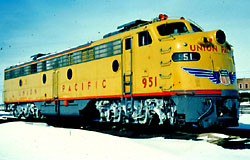RUDOLF DIESEL FIRST DEMONSTRATED the diesel engine in Germany in 1898, but is was not until the 1940s that diesel locomotives were successfully established on both passenger and freight services, in the US. Early diesel locomotives like the "union Pacific" were more expensive to build than steam locomotives, but were more efficient and cheaper to operate, especially where oil was plentiful. One feature of diesel engines is that the power output cannot be coupled directly to the wheels. To convert the mechanical energy produced by the diesel engines, a transmission system is needed. Almost all disel locomotives have electric transmissions and are known as "diesel-electric" locomotives. The diesel engine works by drawing air into the cylinders and compressing it to increase its temperature; a small quantity of diesel fuel is then injected into it. The resulting combustion drives the generator (more recently an alternator) to produce electricity, Which is fed to electric motors connected to the wheels. Diesel-electric locomotives are essentially electric locomotives that carry their own power plants, and are used world wide today. The "Deltic" diesel electric locomotive, the classic express steam locomotives and ran at speed up to 160 kph (100 mph)
 |
| FRONT VIEW OF "UNION PACIFIC" DIESEL-ELECTRIC LOCOMOTIVE 1950s |
| PROTOTYPE "DELTIC" DIESEL-ELECTRIC LOCOMOTIVE 1956 |
 |
| DIESEL ENGINE OF BRITISH RAIL CLASS 20 DIESEL-ELECTRIC LOCOMOTIVE |
No comments:
Post a Comment